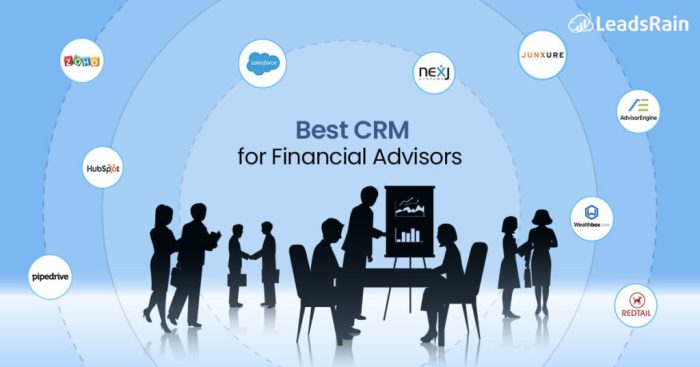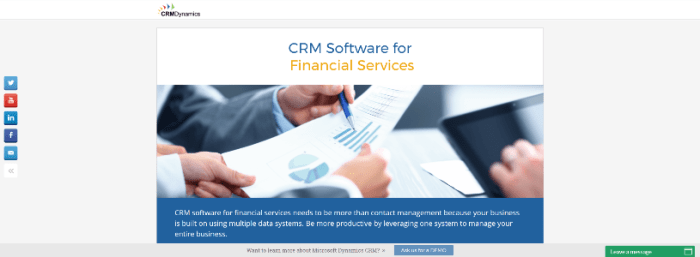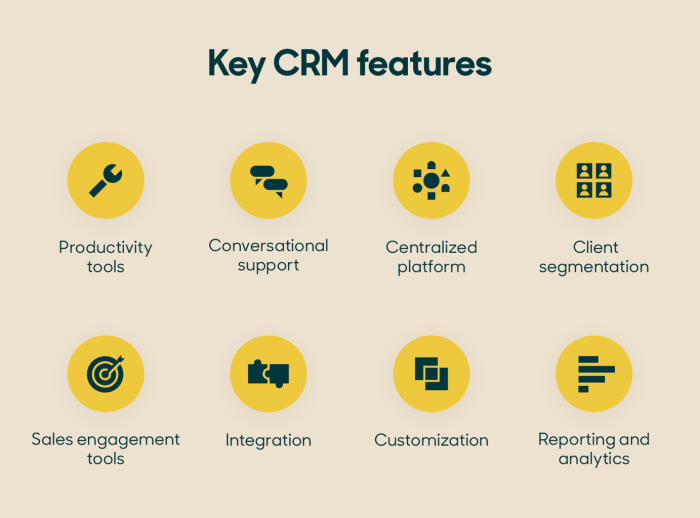CRM software for financial services is revolutionizing how institutions manage client relationships, optimize sales processes, and maintain regulatory compliance. This powerful technology streamlines operations, improves data security, and ultimately enhances the customer experience. From wealth management to lending, the right CRM system can significantly boost efficiency and profitability within the financial sector.
This exploration delves into the diverse types of CRM software tailored for specific financial niches, outlining key features, implementation strategies, cost considerations, and future trends. We’ll examine the critical role of data security and compliance, and provide insights into vendor selection and contract negotiation. The goal is to equip financial professionals with the knowledge necessary to make informed decisions regarding CRM implementation and optimization.
Types of CRM Software for Financial Services
Financial institutions require specialized CRM solutions tailored to their unique operational needs and regulatory environments. Different segments within the financial services industry – wealth management, investment banking, insurance, and lending – have distinct requirements. This section categorizes CRM software solutions based on these segments, highlighting key features and pricing models.
CRM Software Solutions by Financial Services Segment
The following table illustrates various CRM solutions categorized by their target audience within the financial services sector. Note that specific features and pricing can vary based on the vendor and the chosen package.
| Name | Target Audience | Key Features | Pricing Model |
|---|---|---|---|
| Salesforce Financial Services Cloud | Wealth Management, Investment Banking, Insurance, Lending | Client 360 view, regulatory compliance tools, advanced analytics, integration with other financial platforms | Subscription-based, tiered pricing |
| Microsoft Dynamics 365 for Finance | Lending, Insurance | Loan origination management, policy administration, risk management tools, robust reporting | Subscription-based, tiered pricing |
| Adobe Experience Manager | Wealth Management, Investment Banking | Personalized client communication, content management, advanced analytics for client behavior | Subscription-based, tiered pricing |
| Wealth Management Specific CRM (e.g., Redtail Technology) | Wealth Management | Client portfolio tracking, performance reporting, client communication tools, compliance features specific to wealth management | Subscription-based, per-user pricing |
Wealth management CRMs prioritize client portfolio tracking, performance reporting, and personalized communication. Investment banking solutions emphasize deal management, relationship tracking with corporate clients, and regulatory compliance. Insurance CRMs focus on policy management, claims processing, and customer service. Lending CRMs streamline loan origination, risk assessment, and customer relationship management throughout the loan lifecycle.
Deployment Models for CRM in Financial Services
Financial institutions can choose from cloud-based, on-premise, and hybrid CRM deployments. Each model offers different advantages and disadvantages, impacting cost, security, and scalability.
Cloud-based CRM offers scalability, accessibility, and lower upfront costs. On-premise solutions provide greater control over data security and customization but require significant upfront investment and ongoing IT maintenance. Hybrid deployments combine elements of both, offering a balance between control and cost-effectiveness. The optimal choice depends on the institution’s size, IT infrastructure, security requirements, and budget.
Key Features and Functionality
A robust CRM system for financial services needs to encompass core functionalities tailored to the industry’s specific needs, including regulatory compliance and data security. This section details essential features and their integration capabilities.
Essential CRM Features for Financial Institutions

Effective CRM systems for financial institutions must provide a comprehensive suite of features, including client relationship management, lead management, sales pipeline management, and robust reporting and analytics capabilities. Compliance features are crucial for adhering to industry regulations.
- Client Relationship Management (CRM): A 360-degree view of each client, encompassing all interactions and financial data.
- Lead Management: Efficient tracking and nurturing of leads, from initial contact to conversion.
- Sales Pipeline Management: Visual representation of the sales process, enabling effective tracking and management of deals.
- Compliance Features: Built-in tools to ensure adherence to KYC/AML regulations and other industry standards.
- Reporting and Analytics: Data-driven insights into customer behavior, sales performance, and operational efficiency.
CRM Integration with Other Financial Technologies
Seamless integration with other financial technologies is crucial for maximizing the value of a CRM system. This table illustrates potential integrations.
| CRM System | Integrated Technology | Integration Benefits | Implementation Considerations |
|---|---|---|---|
| Salesforce Financial Services Cloud | Payment Gateways (Stripe, PayPal) | Automated transaction processing, improved reconciliation | API integration, data mapping |
| Microsoft Dynamics 365 for Finance | Accounting Software (Xero, QuickBooks) | Real-time financial data updates, streamlined reporting | Data synchronization, API integration |
| Generic CRM (e.g., HubSpot) | Marketing Automation Platforms (Marketo, Pardot) | Targeted marketing campaigns, improved lead nurturing | Data synchronization, workflow automation |
Data Security and Regulatory Compliance
Given the sensitive nature of financial data, robust security measures and adherence to regulatory compliance are paramount when selecting and implementing CRM software. Financial institutions must prioritize systems with strong encryption, access controls, and audit trails. Compliance with regulations such as GDPR, CCPA, and industry-specific rules is mandatory.
Implementation and Integration
Implementing a CRM system in a financial institution requires careful planning and execution. This section provides a step-by-step guide, addressing potential challenges and integration strategies.
Step-by-Step CRM Implementation Guide
- Needs Assessment and Vendor Selection: Define requirements, evaluate vendors, and choose the optimal solution.
- Data Migration: Carefully plan and execute data migration from legacy systems, ensuring data integrity.
- System Customization: Tailor the CRM system to meet specific business needs and workflows.
- User Training: Provide comprehensive training to all users to ensure effective adoption.
- Testing and Go-Live: Thoroughly test the system before deployment and manage the go-live process effectively.
- Post-Implementation Support: Provide ongoing support and maintenance to address any issues and optimize performance.
Challenges and Risk Mitigation Strategies
Implementing CRM systems can present several challenges. These include data migration complexities, user resistance to change, integration issues with legacy systems, and the need for ongoing training and support. Effective risk mitigation strategies include thorough planning, change management initiatives, robust testing, and ongoing user support.
Integrating CRM with Legacy Systems
Integrating a new CRM system with existing legacy systems often requires careful planning and technical expertise. Strategies include using APIs, ETL processes, and middleware solutions to facilitate data exchange and ensure seamless data flow between systems. A phased approach, starting with critical integrations, can minimize disruption.
Cost and Return on Investment (ROI)
Understanding the cost components and calculating the ROI of a CRM system is crucial for justifying the investment. This section breaks down costs and demonstrates ROI calculation.
Cost Components of CRM Software, CRM software for financial services
The total cost of ownership (TCO) for CRM software includes acquisition costs (software licenses, implementation fees), ongoing maintenance (subscription fees, support contracts), and internal resources (training, IT support). Hidden costs such as data migration and integration efforts should also be considered.
Calculating ROI for CRM in Financial Services
Calculating ROI involves comparing the benefits (increased efficiency, improved customer satisfaction, reduced costs) against the costs. Tangible benefits include reduced operational costs and increased sales. Intangible benefits encompass improved customer relationships and enhanced brand reputation. A simple ROI calculation is: (Total Benefits - Total Costs) / Total Costs. For example, if total benefits are $100,000 and total costs are $50,000, the ROI is 100%.
CRM Pricing Models and Associated Costs
| Pricing Model | Cost Description | Advantages | Disadvantages |
|---|---|---|---|
| Subscription | Recurring monthly or annual fees | Predictable costs, scalability | Ongoing expenses |
| One-Time Purchase | Lump-sum payment | Lower long-term costs (potentially) | Higher upfront investment, limited scalability |
| Per-User Licensing | Fees based on the number of users | Scalable, cost-effective for smaller teams | Costs increase with team size |
Vendor Selection and Evaluation
Choosing the right CRM vendor is critical for success. This section Artikels key evaluation criteria and best practices for vendor selection and contract negotiation.
Key Criteria for Evaluating CRM Vendors
- Industry Expertise: Experience serving financial institutions and understanding regulatory requirements.
- Functional Capabilities: Features aligned with specific business needs and industry best practices.
- Integration Capabilities: Seamless integration with existing systems and other financial technologies.
- Security and Compliance: Robust security measures and adherence to relevant regulations.
- Customer Support: Responsive and reliable customer support services.
- Pricing and Licensing Models: Transparent and competitive pricing structures.
Best Practices for Contract Negotiation
Negotiating contracts with CRM vendors requires careful attention to pricing, service level agreements (SLAs), data ownership, and intellectual property rights. It’s essential to have clear expectations and to secure favorable terms.
Comparison of Leading CRM Vendors

Several leading CRM vendors cater to the financial services industry. The following provides a brief comparison (note that vendor strengths and weaknesses can change over time, so independent research is recommended):
- Salesforce:
- Strengths: Extensive features, strong industry expertise, large ecosystem of partners and integrations.
- Weaknesses: Can be complex to implement, high cost.
- Microsoft Dynamics 365:
- Strengths: Robust financial management features, good integration with Microsoft Office suite.
- Weaknesses: May require significant customization for specific needs.
- Adobe Experience Manager:
- Strengths: Excellent for personalized client communication and content management.
- Weaknesses: Primarily focused on marketing and client engagement, may not be as comprehensive for core CRM functions.
Future Trends in CRM for Financial Services

Emerging technologies and evolving customer expectations are shaping the future of CRM in financial services. This section explores key trends.
Impact of AI and Machine Learning
AI and machine learning are transforming CRM by enabling predictive analytics, personalized recommendations, and automated customer service. AI-powered chatbots can handle routine inquiries, while machine learning algorithms can predict customer churn and identify cross-selling opportunities.
Enhancing Customer Experience and Loyalty
CRM systems play a vital role in enhancing customer experience and driving loyalty. Personalized communication, proactive service, and omnichannel support are crucial for building strong customer relationships. CRM data can be used to understand customer preferences and tailor interactions accordingly.
Personalized Financial Advice and Wealth Management
CRM systems are increasingly used to support personalized financial advice and wealth management services. By integrating client data with financial models, CRM systems can provide tailored recommendations and automate portfolio management tasks, leading to improved client outcomes and increased advisor efficiency.
End of Discussion
Implementing the right CRM software is a strategic investment for financial institutions. By carefully considering the various factors discussed – from selecting the appropriate type of CRM and integrating it seamlessly with existing systems to understanding the associated costs and return on investment – financial organizations can significantly enhance operational efficiency, improve client relationships, and drive sustainable growth. The future of financial services hinges on leveraging technology to enhance customer experience, and CRM is at the forefront of this evolution.
Helpful Answers
What are the common compliance issues related to CRM in finance?
Common compliance concerns include data privacy regulations (GDPR, CCPA), anti-money laundering (AML) compliance, and maintaining audit trails for regulatory scrutiny.
How can CRM improve customer retention in financial services?
CRM facilitates personalized communication, proactive service, and targeted offers, fostering stronger client relationships and increasing loyalty.
What is the difference between cloud-based and on-premise CRM?
Cloud-based CRM is hosted externally, offering scalability and accessibility. On-premise CRM is installed on the institution’s servers, providing greater control but requiring more IT resources.
How long does it typically take to implement a financial CRM system?
Implementation timelines vary depending on the complexity of the system and the institution’s size, but can range from several months to a year or more.
